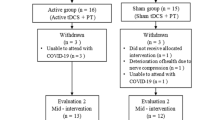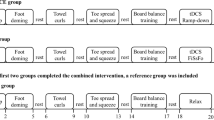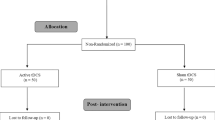Abstract
Background and aims
Transcranial direct current stimulation (tDCS) is a non-invasive neuromodulatory technique that can affect human pain perception. The present open-label, single-arm study investigated whether primary motor cortex anodal tDCS treatment reduces chronic foot pain intensity and improves depression and pain-related anxiety symptoms in patients with chronic plantar fasciitis.
Methods
Ten patients with symptomatic treatment-resistant plantar fasciitis were enrolled in the study. The treatment consisted of anodal tDCS over the motor area of the leg contralateral to the symptomatic foot for 20 min, at 2 mA for 5 consecutive days. Pre-tDCS (T0), post-tDCS (T1), 1 week (T2), and 4 weeks (T3) post-treatment assessments were conducted consisting of the Visual Analog Scale for pain intensity, the Foot Function Index (FFI), the Pain Anxiety Symptom Scale (PASS-20), and the Hamilton Rating Scale for Depression (HDRS-17 items).
Results
Anodal tDCS treatment induced a significant improvement in pain intensity; FFI and PASS scores that were maintained up to 4 weeks post-treatment. In addition, patients reported taking fewer pain medication tablets following the treatments.
Discussion and conclusions
Our results indicate that anodal tDCS may be a viable treatment to control pain and psychological comorbidity in elderly patients with treatment-resistant foot pain.





Similar content being viewed by others
References
Committee on Advancing Pain Research C, and Education, Institute of Medicine (2011) Relieving pain in America: a blueprint for transforming prevention, care, education, and research. The National Academies Press, Washington, DC
Shi Y, Hooten WM, Roberts RO et al (2010) Modifiable risk factors for incidence of pain in older adults. Pain 151(2):366–371
Dunn JE, Link CL, Felson DT et al (2004) Prevalence of foot and ankle conditions in a multiethnic community sample of older adults. Am J Epidemiol 159(5):491–498
Riddle DL, Pulisic M, Pidcoe P et al (2003) Risk factors for Plantar fasciitis: a matched case-control study. J Bone Joint Surg Am 85(5):872–877
Riddle DL, Pulisic M, Sparrow K (2004) Impact of demographic and impairment-related variables on disability associated with plantar fasciitis. Foot Ankle Int 25(5):311–317
Riddle DL, Schappert SM (2004) Volume of ambulatory care visits and patterns of care for patients diagnosed with plantar fasciitis: a national study of medical doctors. Foot Ankle Int 25(5):303–310
Rosenbaum AJ, DiPreta JA, Misener D (2014) Plantar heel pain. Med Clin North Am 98(2):339–352
Smith MT, Edwards RR, Robinson RC et al (2004) Suicidal ideation, plans, and attempts in chronic pain patients: factors associated with increased risk. Pain 111(1–2):201–208
Stubbs B, Schofield P, Binnekade T et al (2014) Pain is associated with recurrent falls in community-dwelling older adults: evidence from a systematic review and meta-analysis. Pain Med 15(7):1115–1128
Tsubokawa T, Katayama Y, Yamamoto T et al (1993) Chronic motor cortex stimulation in patients with thalamic pain. J Neurosurg 78(3):393–401
Nuti C, Peyron R, Garcia-Larrea L et al (2005) Motor cortex stimulation for refractory neuropathic pain: 4 year outcome and predictors of efficacy. Pain 118(1–2):43–52
Lefaucheur JP, Drouot X, Keravel Y et al (2001) Pain relief induced by repetitive transcranial magnetic stimulation of precentral cortex. Neuroreport 12(13):2963–2965
Lefaucheur JP (2006) The use of repetitive transcranial magnetic stimulation (rTMS) in chronic neuropathic pain. Neurophysiol Clin 36(3):117–124
Coffey RJ (2001) Deep brain stimulation for chronic pain: results of two multicenter trials and a structured review. Pain Med 2(3):183–192
Fregni F, Boggio PS, Lima MC et al (2006) A sham-controlled, phase II trial of transcranial direct current stimulation for the treatment of central pain in traumatic spinal cord injury. Pain 122(1–2):197–209
Fregni F, Gimenes R, Valle AC et al (2006) A randomized, sham-controlled, proof of principle study of transcranial direct current stimulation for the treatment of pain in fibromyalgia. Arthritis Rheum 54(12):3988–3998
Paulus W (2003) Transcranial direct current stimulation (tDCS). Suppl Clin Neurophysiol 56:249–254
Priori A (2003) Brain polarization in humans: a reappraisal of an old tool for prolonged non-invasive modulation of brain excitability. Clin Neurophysiol 114(4):589–595
Nitsche MA, Seeber A, Frommann K et al (2005) Modulating parameters of excitability during and after transcranial direct current stimulation of the human motor cortex. J Physiol 568(Pt 1):291–303
Liebetanz D, Nitsche MA, Tergau F et al (2002) Pharmacological approach to the mechanisms of transcranial DC-stimulation-induced after-effects of human motor cortex excitability. Brain 125(Pt 10):2238–2247
Valle A, Roizenblatt S, Botte S et al (2009) Efficacy of anodal transcranial direct current stimulation (tDCS) for the treatment of fibromyalgia: results of a randomized, sham-controlled longitudinal clinical trial. J Pain Manag 2(3):353–361
Mori F, Codeca C, Kusayanagi H et al (2009) Effects of anodal transcranial direct current stimulation on chronic neuropathic pain in patients with multiple sclerosis. J Pain 11(5):436–442
Soler MD, Kumru H, Pelayo R et al (2010) Effectiveness of transcranial direct current stimulation and visual illusion on neuropathic pain in spinal cord injury. Brain 133(9):2565–2577
O’Connell NE, Cossar J, Marston L et al (2012) Transcranial direct current stimulation of the motor cortex in the treatment of chronic nonspecific low back pain: a randomized, double-blind exploratory study. Clin J Pain 29(1):26–34
Dubois PE, Ossemann M, de Fays K et al (2013) Postoperative analgesic effect of transcranial direct current stimulation in lumbar spine surgery: a randomized control trial. Clin J Pain 29(8):696–701
Hagenacker T, Bude V, Naegel S et al (2014) Patient-conducted anodal transcranial direct current stimulation of the motor cortex alleviates pain in trigeminal neuralgia. J Headache Pain 15:78
Borckardt JJ, Bikson M, Frohman H et al (2012) A pilot study of the tolerability and effects of high-definition transcranial direct current stimulation (HD-tDCS) on pain perception. J Pain 13(2):112–120
Price DD, McGrath PA, Rafii A et al (1983) The validation of visual analogue scales as ratio scale measures for chronic and experimental pain. Pain 17(1):45–56
Budiman-Mak E, Conrad KJ, Roach KE (1991) The Foot Function Index: a measure of foot pain and disability. J Clin Epidemiol 44(6):561–570
McCracken LM, Dhingra L (2002) A short version of the Pain Anxiety Symptoms Scale (PASS-20): preliminary development and validity. Pain res Manag 7(1):45–50
Roelofs J, McCracken L, Peters ML et al (2004) Psychometric evaluation of the Pain Anxiety Symptoms Scale (PASS) in chronic pain patients. J Behav Med 27(2):167–183
Hamilton M (1960) A rating scale for depression. J Neurol Neurosurg Psychiatry 23:56–62
Antal A, Terney D, Kuhnl S et al (2010) Anodal transcranial direct current stimulation of the motor cortex ameliorates chronic pain and reduces short intracortical inhibition. J Pain Symptom Manag 39(5):890–903
Carroll D, Joint C, Maartens N et al (2000) Motor cortex stimulation for chronic neuropathic pain: a preliminary study of 10 cases. Pain 84(2–3):431–437
Shin HC, Chapin JK (1990) Mapping the effects of motor cortex stimulation on somatosensory relay neurons in the rat thalamus: direct responses and afferent modulation. Brain Res Bull 24(2):257–265
Mendonca ME, Santana MB, Baptista AF et al (2011) Transcranial DC stimulation in fibromyalgia: optimized cortical target supported by high-resolution computational models. J Pain 12(5):610–617
Lang N, Siebner HR, Ward NS et al (2005) How does transcranial DC stimulation of the primary motor cortex alter regional neuronal activity in the human brain? Eur J Neurosci 22(2):495–504
Lima MC, Fregni F (2008) Motor cortex stimulation for chronic pain: systematic review and meta-analysis of the literature. Neurology 70(24):2329–2337
Leveille SG, Guralnik JM, Ferrucci L et al (1998) Foot pain and disability in older women. Am J Epidemiol 148(7):657–665
Shumway-Cook A, Brauer S, Woollacott M (2000) Predicting the probability for falls in community-dwelling older adults using the Timed Up and Go Test. Phys Ther 80(9):896–903
Vestergaard P, Rejnmark L, Mosekilde L (2006) Fracture risk associated with the use of morphine and opiates. J Intern Med 260(1):76–87
Saunders KW, Dunn KM, Merrill JO et al (2010) Relationship of opioid use and dosage levels to fractures in older chronic pain patients. J Gen Intern Med 25(4):310–315
Caes L, Fisher E, Clinch J et al (2014) The role of pain-related anxiety in adolescents’ disability and social impairment: ALSPAC data. Eur J Pain 19:842
Acknowledgments
Funding for this research was provided by an NYCPM Student Independent Research grant.
Author information
Authors and Affiliations
Corresponding author
Ethics declarations
Conflict of interest
All authors certify that they have not had any financial and personal relationships with other people or organizations that could inappropriately influence or bias this work. There is no conflict of interest for any of the authors.
Ethical approval
The protocol of the study was approved by the ethic committee of the New York College of Podiatric Medicine. All procedures were in accordance with the 1964 Declaration of Helsinki ethical standard and its later amendments.
Informed consent
Informed consent was obtained from all individual participants included in the study.
Additional information
C. Concerto and M. Al Sawah contributed equally to this work.
Rights and permissions
About this article
Cite this article
Concerto, C., Al Sawah, M., Chusid, E. et al. Anodal transcranial direct current stimulation for chronic pain in the elderly: a pilot study. Aging Clin Exp Res 28, 231–237 (2016). https://doi.org/10.1007/s40520-015-0409-1
Received:
Accepted:
Published:
Issue Date:
DOI: https://doi.org/10.1007/s40520-015-0409-1




